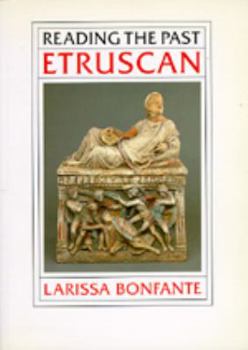Etruscan
(Part of the Reading the Past Series)
Before the rise of Rome, the Etruscans dominated central Italy commercially and culturally. Significantly, it was the Etruscans who passed the alphabet on to the Romans. But in the first century B.C.,... This description may be from another edition of this product.
Format:Paperback
Language:English
ISBN:0520071182
ISBN13:9780520071186
Release Date:September 1990
Publisher:University of California Press
Length:64 Pages
Weight:0.35 lbs.
Dimensions:0.3" x 6.8" x 9.5"
Customer Reviews
3 ratings
Brief, Impressive Introduction to the Language & Stunning Artwork of the Etruscans.
Published by Thriftbooks.com User , 14 years ago
"Etruscan" by Larissa Bonfante is part of the British Museum's "Reading the Past" series that introduces readers to ancient scripts. Etruscan uses an alphabetic script similar to the Greek alphabet, so the author introduces us to the Etruscan language, which took a written form around 700 BC but was extinct by the first century BC, as the Etruscan people adopted Latin and essentially became Roman. Although it was spoken and written in central Italy, Etruscan, like only a few other European languages, is not an Indo-European language. It was an isolated language which must be reconstructed from about 13,000 surviving short inscriptions. Very few lengthy passages of Etruscan survive, which is unfortunate given that Etruscan was apparently a culture that valued literature highly and in which high-quality artwork was a part of everyday life. Etruscan culture and language comes down to us only through archeological finds and references in Greek and Roman literature. "Reading the Past" volumes are typically introductions to how a script works and how it was used, rather than how-to guides to reading the language. That is true of this volume, though you could learn to read a little from it as well. The author provides enough information on grammar, pronunciation, and a short glossary to enable simple translations. A chapter on writing materials and methods provides a tantalizing glimpse into Etruscan culture through illustrations of the engraved images and inscriptions on bronze mirrors, engraved gems, vases, sarcophagi, and more. This shows off the quality of Etruscan artwork, as well as giving us some examples of how the written language was used. It is said that the Etruscans wrote their books on linen. Too bad none have survived. There is also a short chapter on the Oscan language, another language of central Italy, comparing its alphabet to the Etruscan. "Etruscan" is a nice, short (64 pages) introduction to the language and art of the Etruscans, but don't expect it to be in-depth. It's more of a teaser.
Overview of the Etruscan Language
Published by Thriftbooks.com User , 16 years ago
The purpose of this book is to provide an overview of the Etruscan language. Considering that this book is a mere 62 pages long, don't look for detailed studies of Etruscan culture, history, art, etc. If you are looking for a brief yet respectably researched introduction to the language of the Etruscans, as I was, then this book will fit the bill. It is simply amazing how much information is packed into these 62 pages: the linguistic situation in ancient Italy (with excellent maps); a summary of the Etruscan language, including evolution of the alphabet, a guide to pronunciation, and Etruscan grammar as it's currently and incompletely understood; writing materials and methods; and, the bulk of the book, a carefully and thoroughly illustrated section on Etruscan inscriptions, showing mirrors, vases, and sarcophagi, odd choices but apparently our best sources for such inscriptions, and also a catalogue of the inscriptions, with sample inscriptions showing the broad categories into which they fall. Finally, there are two appendices, one listing Etruscan proper names, and the other containing a serviceable Etruscan glossary, and also a brief bibliography touching upon linguistic matters as well as other aspects of Etruscan culture and history.
A Little Short.
Published by Thriftbooks.com User , 17 years ago
The focus of this book appears to be the huge influence the Etruscans had on the Romans. They passed on the traditions of the Roman alphabet, augury, & funerary games. She lightly touches on topics like jewelry, pottery, tomb art. The section on mythological scenes on the backs of mirrors stood out as the most new info on the Etruscans I have read in ages. She points out that Etruscan art was far more realistic than most of their contemporaries, a fact which is still rarely mentioned. Lastly, there is a good glossary of Etruscan words & their meanings. I suggest the reader read this with Agnes Carr Vaughans book on the Etruscans. The 2 together will fill in the gaps on a very interesting people.






